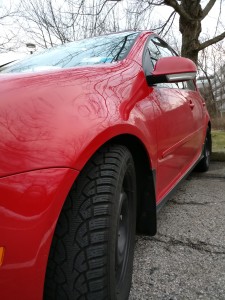The Case For Snow Tires 2016/2017
by Peter Andersen
Back in 2014, I wrote a blog on snow tires. With Winter Storm Fortis hitting hard to our north, I realize that it is that time once again for a quick edit and repost. Levitt-Fuirst knows insurance, so consider this piece a different type of insurance – because sometimes insurance comes in a policy, but sometimes it comes in the form of 4 wheels ready to tackle the white stuff that is sure to follow.
As the temperatures dip and the winter season arrives, it is time to think about snow tires (again).
But I Have All-Season Tires!
If you bought your car in the northeast, you were given All-Season Tires by default. Many people feel that their all-season tires are designed to survive winter’s wrath, but they are actually designed to do everything pretty well. Rain, not bad. Dry, perfectly fine. Race Track, meh, not so much. Snow? Ummmm… Snow? Not so good, really. If we get 3 or 4 inches of the white stuff, if you don’t go up or down hills much at all, if you can leave your car at home and take a train, then you could be set! For the rest of you, however, driving up and down hills and to and from work, taking your kids to school or driving mom to the airport; snow tires are just the kind of insurance for your family that makes a whole lot of sense.
Why snow tires? First, read a basic Q&A here, at About Cars… This is a few years old, but as true today as it was when it was written. As you can see, snow tires are made of special rubber, they have tread designs specific to the needs of snow and ice, and they make a huge difference in your driving safety when the white stuff falls. Even on dry pavement, the rubber is more pliable when the temps dip into the teens – while your all seasons get hard and brittle in the winter, snow tires stay soft and grippy. If you need your car daily, there is no better investment in the northeast than snow tires, making your 2 or 4 wheel drive vehicle safe and secure as you commute. Wait, even all wheel drive cars need snow tires??? YES! All wheel drive + snow tires turns your SUV into the perfect winter travel companion, taking on all that winter can send your way. Without them, you will have just as hard a time stopping as the rest of us…
Does your taste run more toward sporty cars? The biggest benefit for you is you can buy summer tires for the other 3 seasons, and have snow tires for the winter. You can improve your driving in wet and dry during the warmer months, and because those expensive sticky treads will be in your garage for 4 months each year, they should last you about 33% longer. One last note on sports cars – if you have a rear wheel drive daily-driver, go to a tire store and buy snow tires. Now. Really! Go, we will wait… Your sports car is nearly useless without them in a standard snow storm…
Are You Sold? Good! You Have Two Options…
Option 1: If you have a small or economy car, you likely have wheels in the 15″ – 16″ size range. This is a good size for snow tires, so you can have them installed right on your current rims. This requires a repair shop or tire store to do the install. The benefits are you only have to pay for the tires and installation, the drawback is that you have to pay for that installation twice a year, as you switch between your winter and summer tires.
Option 2: Get a totally separate set of wheels with your winter tires (as I have done with my VW, shown in the picture). You may see the term “Steelies” used for steel wheels that are often utilized for this purpose. For those of you with 18″ wheels or larger on your performance vehicle, this option may save you some money on the snow tires, as winter tires for large diameter wheels are expensive and less effective. Winter tires work well on smaller wheels because the tire sidewalls are larger than the low profile sport tires your car likely came with. My car, for example, has 18′ wheels with low profile tires, but I use 16′ steelies and winter tires – and paid less for the tires. The drawback to this option is the initial cost, as steelies run from $50 to $100 per wheel, and you may need 4 tire pressure sensors installed as well – a one-time charge, dependent on your car. The benefit is the ease of switching the wheels between seasons (your shop will charge you less, or you can do it yourself if you have a jack), and that you will have the wheels winter after winter. You also save your pretty shiny wheels from the winter salt and punishing ice, making them look better for longer.
Now? Sigh…
Winter is here, so now is the time! Contact one of the many retailers that sell those winter tires, because you need them more than you realize. You may be able to get some used rims off of Craig’s List, or order them online to save a few dollars. Store your summer tires for the year in your shed, garage or basement (always on their side, stacked), and enjoy the next 4 months without worry. You won’t believe the change in your car during the next storm! Now drive smart, drive carefully, and get there safe.
Links:
Tire Rack: Find the right tire for your car (or buy a set with wheels included)
Top 10 Winter Tires (Insurance Hotline, a Canadian site – because they know snow…)


